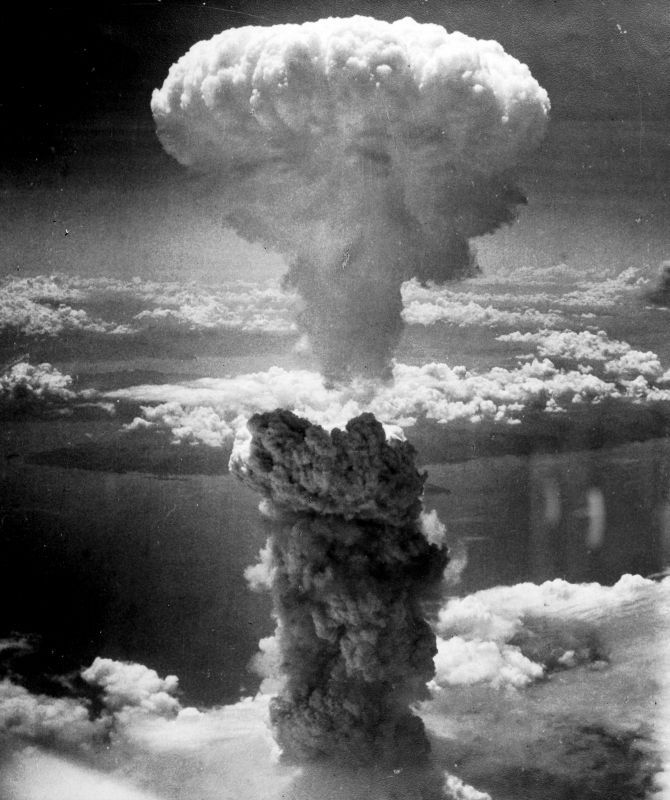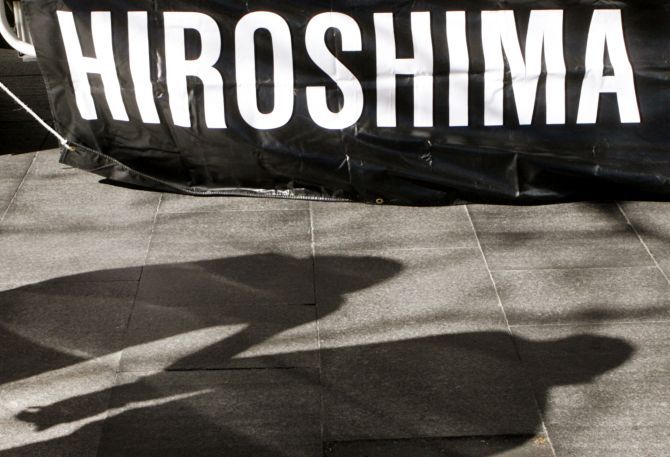 | « Back to article | Print this article |
On the morning of 6 August 1945 an American B-29 bomber, the 'Enola Gay', dropped the first atomic bomb used in warfare on the Japanese city of Hiroshima.
Hiroshima and Nagasaki became the first cities in the world to witness the terrible power of atomic age weapons.
The blast radius was greater than ten square kilometres (six square miles). And the intense heat of the explosion then created many fires, which consumed Hiroshima and lasted for three days, trapping and killing many of the survivors of the initial blast. Thousands of people were made homeless and fled the devastated city.
To this day, the shadows of the victims lay imprinted on the walls of these cities. As the world mourns and remembers that portentous day, Rediff.com looks at some interesting facts about Hiroshima and Nagasaki and how that tragedy changed the world.

A woman kneels in front of a banner calling for peace in front of the Atomic Bomb Dome in Hiroshima, which marks on Thursday the 70th anniversary of the attack on Hiroshima, where the US dropped an atomic bomb, killing about 140,000 by the end of the year in a city of 350,000 residents. Photograph: Thomas Peter/ Reuters
1. Fair warning: The US Airforce before dropping the A-bomb, dropped pamphlets in Hiroshima warning people of the bombing.

2. The man who survived two atomic bombs: Tsutomu Yamaguchi survived the atomic blast at Hiroshima, dragged himself into an air-raid shelter, spent the night there, in the morning caught a train so he could arrive at his job on time in Nagasaki, where he survived another atomic blast.

3. A tale of Oleander: The oleander is the official flower of the city of Hiroshima because it was the first thing to bloom again after the explosion of the atomic bomb in 1945.

A couple walks past a placard during an anti-nuclear demonstration demanding the abolition of nuclear weapons. Photograph: Daniel Munoz/ Reuters
4. Hiroshima mon amour: When the atomic bomb was dropped on Hiroshima, the intensity of the blast was of such intensity that it permanently burned shadows of people and objects into the ground. These spectral tinctures were later called ‘Hiroshima shadows’.

Japan's favourite movie monster Godzilla was made in response to the Hiroshima-Nagasaki blasts. Photograph: Reuters
5. The monster within: Gojira, more popularly known as Godzilla, was created by Japan’s Toho Studios as a reaction to Hiroshima. In the original 1954 movie, the monster spawns as a result of the nuclear detonations of Hiroshima and Nagasaki thus making the film a cautionary tale against the dangers of an atomic age. Interestingly, Godzilla’s skin texture is inspired by the Keloid scars that grew on Hiroshima survivors.

A copy of "Little Boy", the atomic bomb that was dropped on Hiroshima, rests beneath the fuselage of the Enola Gay, the B-29 that delivered the bomb, at the Smithsonian Air and Space Museum. Photograph: Reuters
6. ‘The Maltese Falcon’ connection: The bomb dropped over Hiroshima was codenamed ‘Little Boy’ whereas the Nagasaki bomb was called ‘Fat Man’. The Nagasaki bomb was named after Sydney Greenstreet’s character in The Maltese Falcon whereas the ‘Little Boy’ bomb was named after Greenstreet’s henchman, Elisha Cook, Jr.’s character, in the same film. Both codenames are the nicknames of the characters as referred to by Humphrey Bogart.

7. The flora that made it through: Ginkgo biloba, a unique species of trees with no living relatives, is a living fossil. At an age of 270 million years, Ginkgo has survived many mass extinction events. Its persistence to survive was seen in Hiroshima, where six Ginkgo trees within a few miles of target zero were among the very few living things in the area to have survived. The trees heal quickly and are alive to this day.

Flame of Peace is seen at Peace Memorial Park where commemorating those who died in the battle of Okinawa during World War II. Photograph: Kyodo/ Reuters
8. A never-ending struggle: The Hiroshima Peace Memorial Park was built on the open field created by the explosion. It is dedicated to the memory of Hiroshima being the first city on earth to experience the horrors of the atomic age. One of its monuments present here is the Peace Flame which was lit in 1964 and will continue to do so until all nuclear weapons on the planet are destroyed.

Colonel Paul Tibbetts poses in front of his B-29 Superfortress "The Enola Gay" (named for his mother) in this undated US Air Force handout photo. The Enola Gay is the same plane he piloted when his bombardier dropped the first atom bomb over Hiroshima, Japan. Photograph: US Air Force/ Reuters
9. The good American: The US Air Force pilot who dropped the first atomic bomb died at aged 92 having no regrets for his actions. Pilot Paul Tibbets said he never lost a single nights sleep over having dropped the bomb that killed 78,000 people in one instant.

Leonard Reiser, chairman of the Bulletin of the Atomic Scientists and member of the Manhattan Project adjusts the Doomsday Clock ahead from 14 minutes to nine minutes before midnight June 11 in Chicago. The move symbolises the planet moving closer to nuclear peril. Photograph: Reuters
10. The Doomsday Clock ticks on: In response to the Hiroshima-Nagasaki explosions the Bulletin of the Atomic Scientists started publishing a clock on their cover marking mankind’s proximity of a nuclear war.
Since its inception, the now infamous clock has been depicted on every cover of the Bulletin. Its first representation was in 1947, and has been defined as “a gauge intended to reflect basic changes in the level of continuous danger in which mankind lives in the nuclear age.”